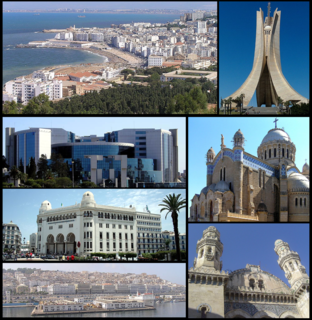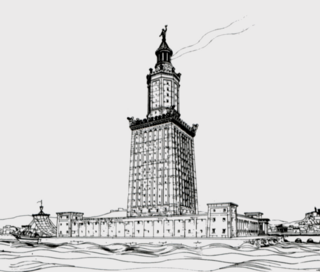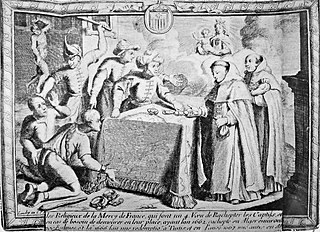Related Research Articles

Algiers is the capital and largest city of Algeria. The city's population at the 2008 Census was 2,988,145 and in 2011 was estimated to be around 3,500,000. An estimate puts the population of the larger metropolitan city to be around 5,000,000. Algiers is located on the Mediterranean Sea and in the north-central portion of Algeria.

The Lighthouse of Alexandria, sometimes called the Pharos of Alexandria, was a lighthouse built by the Ptolemaic Kingdom, during the reign of Ptolemy II Philadelphus, which has been estimated to be at least 100 metres (330 ft) in overall height. One of the Seven Wonders of the Ancient World, for many centuries it was one of the tallest man-made structures in the world.

A plough or plow is a farm tool for loosening or turning the soil before sowing seed or planting. Ploughs were traditionally drawn by oxen and horses, but in modern farms are drawn by tractors. A plough may have a wooden, iron or steel frame, with a blade attached to cut and loosen the soil. It has been fundamental to farming for most of history. The earliest ploughs had no wheels, such a plough being known to the Romans as an aratrum. Celtic peoples first came to use wheeled ploughs in the Roman era.

David Livingstone was a Scottish physician, Congregationalist, and pioneer Christian missionary with the London Missionary Society, an explorer in Africa, and one of the most popular British heroes of the late 19th-century Victorian era. He had a mythic status that operated on a number of interconnected levels: Protestant missionary martyr, working-class "rags-to-riches" inspirational story, scientific investigator and explorer, imperial reformer, anti-slavery crusader, and advocate of British commercial and colonial expansion.

Fort Sumter is a sea fort in Charleston, South Carolina, notable for two battles, the first of which signified the start of the American Civil War. It was one of a number of special forts planned after the War of 1812, combining high walls and heavy masonry, and classified as Third System, as a grade of structural integrity. Work started in 1829, but was incomplete by 1860, when South Carolina seceded from the Union.

Geronimo was a prominent leader and medicine man from the Bedonkohe band of the Apache tribe. From 1850 to 1886, Geronimo joined with members of three other Chiricahua Apache bands — the Tchihende, the Tsokanende and the Nednhi — to carry out numerous raids, as well as fight against Mexican and U.S. military campaigns in the northern Mexico states of Chihuahua and Sonora and in the southwestern American territories of New Mexico and Arizona. Geronimo's raids and related combat actions were a part of the prolonged period of the Apache–United States conflict, which started with American settlement in Apache lands following the end of the war with Mexico in 1848.

The Pequot War was an armed conflict that took place between 1636 and 1638 in New England between the Pequot tribe and an alliance of the colonists of the Massachusetts Bay, Plymouth, and Saybrook colonies and their allies from the Narragansett and Mohegan tribes. The war concluded with the decisive defeat of the Pequots. At the end, about 700 Pequots had been killed or taken into captivity. Hundreds of prisoners were sold into slavery to the West Indies; other survivors were dispersed as captives to the victorious tribes.

The Battle of Plassey was a decisive victory of the British East India Company over the Nawab of Bengal and his French allies on 23 June 1757, under the leadership of Robert Clive which was possible due to the defection of Mir Jafar Ali Khan, who was Siraj-ud-Daulah's commander in chief. The battle helped the Company seize control of Bengal. Over the next hundred years, they seized control of the entire Indian subcontinent and Myanmar - and briefly Afghanistan.

Occhiali was an Italian farmer, then Ottoman privateer and admiral, who later became beylerbey of the Regency of Algiers, and finally Grand Admiral of the Ottoman fleet in the 16th century.

The Bombardment of Algiers was an attempt by Britain and the Netherlands to end the slavery practices of Omar Agha, the Dey of Algiers. An Anglo-Dutch fleet under the command of Admiral Edward Pellew, 1st Viscount Exmouth bombarded ships and the harbour defences of Algiers.

The Convoy of 35, was a convoy of Haganah fighters sent during the 1947–48 Civil War in Mandatory Palestine on a mission to reach by foot and resupply the blockaded kibbutzim of Gush Etzion in January 1948, after earlier motorized convoys had been attacked. They were spotted before they could reach their target and killed in a prolonged battle by Arab irregulars and local villagers.

Saldae was an important port city in the ancient Roman Empire, located at today's Béjaïa. It was generally a crossroads between eastern and western segments of Northern Africa, from the time of Carthage to the end of the Byzantine Empire from the continent.

Samuel Marinus Zwemer, nicknamed The Apostle to Islam, was an American missionary, traveler, and scholar. He was born at Vriesland, Michigan. In 1887 he received an A.B. from Hope College, Holland, Mich., and in 1890, he received an M.A. from New Brunswick Theological Seminary, New Brunswick, N. J.. His other degrees include a D.D. from Hope College in 1904, a L.L.D. from Muskingum College in 1918, and a D.D. from Rutgers College in 1919.

Emmet Crawford was an American soldier who rose through the ranks to become an officer. He was most noted for his time spent in the Arizona Territory under General George Crook in the United States Cavalry. He was killed in pursuit of the Apache leader Geronimo in January 1886 in Mexico.

William Whiting Borden was a philanthropist and millionaire Christian missionary candidate who died in Egypt before reaching his chosen field, Gansu province in China.

The Barbary slave trade refers to slave markets on the Barbary Coast of North Africa, which included the Ottoman provinces of Algeria, Tunisia and Tripolitania and the independent sultanate of Morocco, between the 16th and middle of the 18th century. The Ottoman provinces in North Africa were nominally under Ottoman suzerainty, but in reality they were mostly autonomous.

Icosium was a small Punic and Berber city that became an important Roman colony and an early medieval bishopric in the casbah area of actual Algiers.

HMS Ringdove was a Royal Navy 18-gun Cruizer-class brig-sloop that Matthew Warren built at Brightlingsea and launched in 1806. She took some prizes and participated in three actions or campaigns that qualified her crew for clasps to the Naval General Service Medal. The Admiralty sold her in 1829 to Samuel Cunard, who would go on to found the Cunard Line.

The Crawford affair was a battle fought between Mexico and the United States in January 1886 during the Geronimo Campaign. Captain Emmet Crawford was commanding a company of Apache scouts, sixty miles southeast of Nacori Chico in Sonora, when his camp was attacked by Mexican Army militiamen. In the action, Crawford was shot and later died; his death nearly started a war between the United States and Mexico.

Reverend James Cantine, D.D. was an American missionary, scholar, and traveler. While studying at New Brunswick Theological Seminary in New Jersey, he co-founded the Arabian Mission with John Lansing and Samuel Marinus Zwemer. The mission exists today as the American Mission Hospital of Bahrain. He was a missionary for forty years, which included establishing the first mission for the Reformed Church in Arabia, which was also the first mission in eastern Arabia. Between 1891 and 1929, he established mission posts, medical clinics, and churches in Arabia.
References
- Zwemer, Samuel M. (F.R.G.S.) (1920s). Call to Prayer (PDF). London: Marshall Brothers. p. 14ff. Retrieved 26 July 2017.
- Zwemer may have been inspired by a reference found in Morell, John Reynell (1854). Algeria: The Topography and History, political, social and natural of French Africa. London. (this book has not been checked).
| This article about a saint is a stub. You can help Wikipedia by expanding it. |